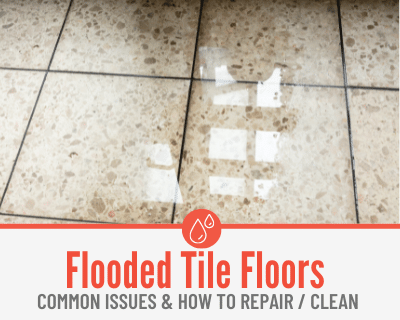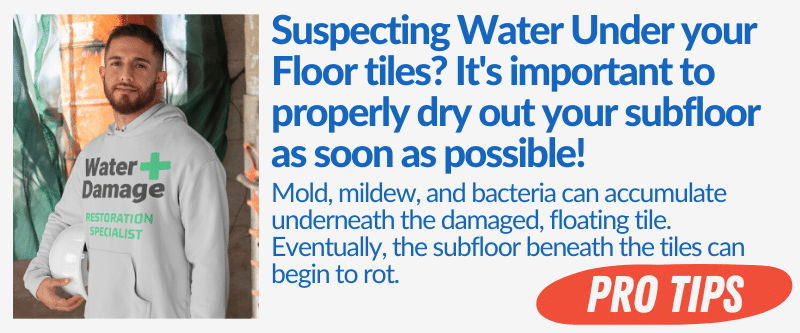If you’ve recently discovered flooded tiles in your home, you’ve come to the right place.
In this guide you will learn:
- If Tiles Can withstand Flood & Large amounts of water,
- Common issues with Flooded Tile floors,
- How to Repair & Dry out your water damaged tile floors,
- How to Clean tile floors after a flood.

Can Tile Floors Withstand a Flood?
Multiple factors might affect how well your tiles can withstand flooding.
First, the material of the tiles will determine its level of water resistance. It is important to note that no tile is entirely waterproof on its own, although some may offer high levels of water-resistance.
The virtuosity of tile will determine the level at which it retains water. Viscosity ranges from non-vitreous to impervious tiles, with impervious tiles being the most water-resistant.
Although no tile is entirely waterproof, tile is an excellent choice against flooding. Most tiles, especially impervious tiles like porcelain, will offer high resistance to mold and mildew.
It can be important to note that while tile itself is resistant to water, it does not create an impermeable shield, meaning that the subfloor might be damaged or subject to rot in the event of a flood.
What To Do When Your Tile Floor Has Flooded
If your tile has flooded, there are a few actions you can take before calling a professional. The first step will be to assess the damage.
Not only will this help avoid future damage, it will also help assess damage level. Water that sources from the ground up will contain microorganisms, as well as have direct access to the subfloor.
Water coming from below thus creates an environment prone to creating mold and mildew, regardless of the virtuosity of the tiles.
Flood water from above is safer to handle by yourself, as it is oftentimes cleaner water and less likely to have seeped through to the subfloor.
Tile Floors Damaged by Flood?
Call 844-488-0570 for a Risk Free estimate from a Licensed Water Damage Restoration Specialist in your area.
We Can Help Dry out the Tiles and Subfloor, as well as repair any water damage.
Common Issues With Flooded Tile Floors & Repair Techniques.
It is common for tile or flooring to become damaged after a flood. This section will cover certain common damages on different types of tiles, as well as some potential solutions.
Ceramic Tile
Ceramic tile can range from non-vitreous to impervious. It can be helpful to check with the tile manufacturer where your tiles fall.
Impervious tiles, as previously mentioned, are more water-resistant , whereas non-vitreous tiles tend to absorb more water. Non-vitreous tiles may need to be replaced altogether.
Repairing Ceramic Tile Floors Damaged by Water.
Cracking: Although flood water will not damage your ceramic tiles, it may damage the grout surrounding them. This unsettlement may cause your tiles to crack.
While cracking is not usually serious, it is still important to replace or repair cracked tiles in order to avoid further damage, such as larger cracks, water access to the subfloor, and mold growth.
Minor cracks
Minor cracks may be repaired at home with the following instructions:
- Thoroughly clean the tile with soap and water. Proceed to dry the minor crack while removing any dust or tile fragments.
- Obtain clear epoxy and mix it according to the manufacturing label.
- Once mixed, apply the epoxy onto the crack. Be careful to properly level the epoxy.
- Following manufacturing instructions, allow the epoxy to settle and cure.
- Once the epoxy is cured, paint over the tile using your choice of epoxy safe paint and brush.
Major cracks
Major cracks in tiles after flooding will require the removal of the affected tile. This can be done following these instructions:
- Start by cleaning the tile and the surrounding area with water and soap, being careful to remove any leftover grout or tile fragments. Then, thoroughly dry the tile and affected area.
- Before proceeding, use safety glasses, construction gloves, a respirator and a long sleeve shirt.
- Remove all the grout using a manual grout saw. To do so, simply scrape away at the grout with the grout saw.
- Drill pilot holes into the center of the tile.
- Using a hammer and a chisel, start to disassemble the tile into smaller fragments to pry it up. You can do so by inserting the chisel into your pilot holes. Ridge marks will indicate you have reached your desired depth.
- To the best of your ability, chisel away the existing mortar.
- Vacuum away all dust, tile and grout fragments.
- Using your new tile, check that the fit is accurate and correct. To do so, you may use a level placed on top of the tile.
- Mix your desired thin set mortar and dampen your backing floor with a moist sponge.
- Apply your thin set mortar using a notched trowel. The mortar should be applied first to the backing floor, then a thin coat should be applied to the new tile. Continue adjusting the amount of mortar until your tile sits level with the other tiles.
- Place down the new tile. Clean away the excess mortar spilling through the edges.
- Follow manufacturing instructions to allow your thin set mortar to dry. Once dry, vacuum the remaining dust away from the edges.
- Using a grout float, carefully work your grout into the joints of the tile. Once the joints are filled, clear away the excess using your grout float.
- Use a clean sponge to wipe away the remaining grout.
- Following manufacturer instructions, allow your grout to cure and dry.
Loosening or Hollowing
If tiles have been submerged for some time in the flood water, they may begin to loosen. Loosening is slightly more serious than cracking, as it then becomes a safety hazard.
- Loose water and flood damaged tiles can be fixed either by replacing them, as detailed in the section above, or by using a sealing floor adhesive. A popular and easy choice would be Fix-A-Floor, which is available at hardware stores and online.
- Begin by cleaning the area over and around the affected tiles with a vacuum.
- Select a drill bit or a syringe that is small enough to fit between the grout lines without touching any of the surrounding tiles.
- Using said drill bit, drill four-to-six pilot holes surrounding the problem area. If the affected area spans over more than four tiles, repeat these steps for each set of four tiles.
- Vacuum up any fragments of grout or dust caused by the drilling.
- With the help of a caulking gun, fill the pilot holes with the adhesive. There may be an overflow from the neighbouring holes; this is normal.
- Wipe up any excess adhesive with a wet sponge.
- Follow manufacturer instructions for adding weight to the tile, if necessary.
- Follow manufacturer instructions for allowing the adhesive to dry.
- Once completely dry, fill the pilot holes with your desired grout using a grouting float. To blend the edges of the grout, use a damp sponge.
- Follow manufacturer instructions to allow the grout to dry.

Common Issues for Porcelain Tile After Flood
Cracking: Even though water after the flood will not damage your porcelain tiles, it may damage the grout surrounding them. This unsettlement may cause your tiles to crack.
Though cracking isn’t inherently serious, it is still crucial to repair or replace cracked tiles to avoid further, more serious damage.
To fix minor and major cracks, please refer to the section under Ceramic Tiles for instructions on how to repair or replace cracked tiles.
Loosening or Hollowing: If porcelain tiles have been submerged for some time in the flood water, they may begin to loosen. Loosening is slightly more serious than cracking, as it becomes a safety hazard.
- Loose tiles can be fixed either by replacing them, as detailed in the section above, or by using a sealing tile floor adhesive. A popular and easy choice would be Fix-A-Floor, available at hardware stores and online.
Common Issues for Natural Stone Tile After Flood
Cracking: While Clear flood water will not damage your natural stone tiles if dried out fast enough, it may damage the grout surrounding them. This unsettlement may cause your tiles to crack.
If you have Category 2 flood water damage ( contaminated floodwater or) Or Category 3 Water damage ( Grossly contaminated Blackwater which can contain sewage) you might have a problem.
If the floodwater is removed quickly enough, this type of water can and will stain your Natural Stone tiles.
As previously mentioned, cracking isn’t typically a very serious issue, though it is still important to replace or repair cracked tiles to avoid further damage.
To fix minor and major cracks, please refer to the section under Ceramic Tiles for instructions on how to repair or replace cracked tiles.
Loosening or Hollowing: If natural stone tiles have been submerged in floodwater for some time, they may begin to loosen. Loosening is slightly more serious than cracking, as it becomes a safety hazard.
- Loose tiles can be fixed either by replacing them, as detailed in the section above, or by using a sealing floor adhesive. A popular and easy choice would be Fix-A-Floor, available at hardware stores and online.
How To Clean Tile Floors After Flood
If your tiles have recently been flooded, they will need to be sanitized in order to avoid mold growth. The following instructions will provide a thorough cleaning option.
- First, start by checking the subfloor. If the subfloor is wet from the flood, it is best to call a professional to do the cleaning, as improper methods could result in subfloor rot.
- Once the entire tile floor is dry and repaired as needed, start by washing the surface with warm water, soap and a sponge.
- Dry the surface of the clean tiles.
- Mix one cup of bleach for 19 liters of water. Be sure to wear proper protective equipment such as glasses and gloves. Sanitize the tile floor with this mixture.
- Once the tile floor is sanitized, allow the tile to dry.
If there is mold on your subfloor after the flood, you may need to take an extra step to create a stronger mixture.
- First, start by checking the subfloor. If the subfloor is wet, it is best to call a professional to do the cleaning, as improper methods could result in subfloor rot.
- Once the entire tile floor is dry and repaired as needed, start by washing the surface with warm water, soap and a sponge.
- Dry the surface of the clean tiles.
- Mix one cup of bleach for 3.7 liters. Be sure to wear proper protective equipment such as glasses and gloves. Sanitize the floor with this mixture.
- Once the floor is properly sanitized, allow the floor to dry.
Cleaning Floor Tile Grout After Flood
After your tiles have been cleaned, you may notice that dirt or even mold continues to reside in the grout of your tiles. Follow these instructions to remove the last of the remnants from the flood.
- First, mix ¾ cups baking soda, ¼ cup hydrogen peroxide and 1 tablespoon of dish soap.
- Using warm water and a grout brush, or any compact, dense bristle brush, scrub the grout until the dirt starts to lift.
- Apply the initial mixture and continue to scrub the grout until a clean appearance is achieved.
- Rinse away the remainder of the mixture.
- With a damp cloth, wipe down the grout one last time, then allow it to dry.

Should Tile Floor Be Replaced After a Flood?
Unfortunately, after a flood, some tiles may need to be replaced. Here are some common problems that you may face, along with some insight as to whether or not you should replace your tile.
Cracking
As mentioned before, minor cracks can be repaired and are not serious. On the other hand, major cracks may pose safety risks, and a tile replacement is strongly recommended.
Loosening
Loosening may pose a tripping or mold growth hazard, and is therefore slightly more serious than cracking. It is still, however, not catastrophic damage, and can be repaired at home.
If using certain products, such as the ones detailed above, you may not need to replace your tile. If you don’t have access to these products, it is best to replace the affected tiles entirely.
How to Prevent Mold After Flood on Tile Floor
Once you’re sure that all the mold has been removed from your floor, you may take some steps to prevent further mold growth.
Following the above steps (under the “How To Clean Tile Floors After Flood” section) will not only help clean your tiles, it will also help kill and remove mold.
To prevent further mold from forming, keep your tile floors dry and clean them regularly with the aforementioned mixture and sanitizer.
Are Floor Tiles Covered by Flood Insurance
Generally, tiles are covered by flood insurance. However, every policy will have unique wordings and coverages.
When in doubt, contact your insurance advisor for policy coverages.
When To Call a Professional?
Although many repairs are safe to do at home, some situations call for professional help specially when it comes to tiles that have been affected by large amounts of flooded water.
Always call a professional for help cleaning dangerous substances such as a substantial amount of mold or contaminated water.
Professional help is also always available to help you fix anything above your comfort level.
It is also crucial to call an expert in situations where the subfloor has been damaged, affected by mold or affected by rot.
Overall, a combination of vigilant action and expert help will allow you to safely and efficiently restore your tile flooring after a flood.
We have Water Damage Restoration Technicians that can help Dry out and Repair Your Water Damaged Tiles & Subfloor under them.
For Disasters of all Sizes, available in 95% of the USA
